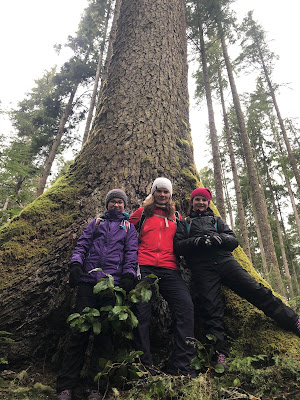Rebecca grew up in a small rural town. Her family didn’t go on camping trips, but she had the freedom to roam the “back 40” on her grandparent’s farm, to camp in a bluff of trees on the outskirts of town, to explore the creek, and toboggan on her own. Today’s kids don’t have the same freedom, leaving it up to parents to create opportunities for outdoor experiences. Parents recognize that risky play is good for kids, but they also want to ensure their children’s safety.
“When I joined Saskatoon Search and Rescue, I really connected with the modern idea of outdoor adventure,” Rebecca says. “It reignited the part of me that always wanted to be outdoors as well as reinforcing my belief in the importance of being prepared.” Rebecca began hiking and camping more, at first by herself but then with her family.
“Keeping it safe depends on the right choice of activity, place, and equipment,” she says. It’s also about progressively introducing new elements. Rebecca emphasizes the importance of starting small and building up to bigger adventures. “If I’m comfortable, then I’m comfortable taking my kids,” Rebecca says. For example, Rebecca rented a paddleboard for her first trips and stayed local. Once that felt comfortable, she bought her own paddleboard and started going on overnight trips. It was only once she felt completely comfortable on her solo adventures that she introduced her kids to paddleboarding – for a local trip on a day when the weather was great.
Be Prepared
Safe outdoor adventures start at home by ensuring that you are ready and equipped for your adventure. Being prepared encompasses everything from checking the weather forecast to ensuring you have the appropriate equipment (and that it’s in good working order). Be sure you have a backup plan. And be sure you carry a first aid kit.
“There’s no excuse for not taking a first aid kit,” Rebecca says. “It doesn’t have to be a large massive bag. Kids can carry a zippy bag with bandaids, tensor bandage, and gauze. I have a few extra things in my kit.”
Rebecca firmly believes that kids of all ages should have a backpack and carry some of their own gear.
All children should have water, a jacket, extra socks or mitts, and a whistle (“Kids’ voices don’t carry far in the woods,” Rebecca says).
A head lamp or flashlight is also recommended. “We get into the trap of only packing for the immediate activity rather than being prepared for future needs,” Rebecca explains. “Packing a head lamp means you can stay out late and watch the sunset or have parental peace of mind if your child gets lost and you’re searching for them in the dark.”
When her kids were small, Rebecca always included a small toy in their backpacks to distract them if they were bored or alone. “It’s healthy preparedness,” Rebecca says. “If they were to get lost, I’d feel better knowing that they had something to help them through the hours until I can find them.”
What is included in your child’s backpack will change as they grow older. Rebecca’s daughters now carry a knife and firestarter because they’ve been taught how and when to use them to start a fire.
Progressive Adventures
Some of Rebecca’s first trips with her family were to familiar places such as Beaver Creek. It felt far away, but it was still close to home. It was practice for her as a mother but an adventure for the kids.
Once you and your kids are comfortable with an activity and have gained confidence in your abilities, you’re ready to take it to the next level, such as multi-day activities or better equipment. Rebecca’s daughters are now operating their own snowmobiles, but they’ve built up to that degree of power and speed, and Rebecca is comfortable about their safety.
Resources
There is a wealth of online information. The EcoFriendly Sask website lists opportunities for summer and winter outdoor adventures as well as a list of nature programs for kids. Both Nature Regina and Wild About Saskatoon offer outdoor activity guides for their respective cities, and SaskOutdoors offers a wide range of workshops and activities.
Rebecca highly recommends the AdventureSmart and Hug a Tree and Survive programs that help lost kids survive in the woods. “As a parent, it’s my worst nightmare if I couldn’t find my child,” Rebecca says. “I’ve always taught them what to do if lost.”
Rebecca’s company, Back 40 Wilderness First Aid, offers a variety of wilderness first aid courses. In addition to the certification programs, she offers custom classes that can be tailor-made to fit a family or an organization’s particular needs. Rebecca is also considering offering youth courses in future.
EcoFriendly Sask supports Saskatchewan environmental initiatives through an online publication, an events calendar, small grants, and the Nature Companion website/app.
You can follow EcoFriendly Sask by liking us on Facebook, following us on Twitter, or by email (top right corner).


